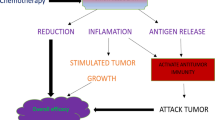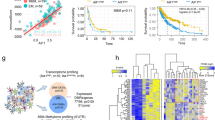Abstract
Glioblastoma (GBM) is one of the most aggressive tumors. Numerous studies in the field of immunotherapy have focused their efforts on identifying various pathways linked with tumor-induced immunosuppression. Recent research has demonstrated that metabolic reprogramming in a tumor can contribute towards immune tolerance. To begin to understand the interface between metabolic remodeling and the immune-suppressive state in GBM, we performed a focused, integrative analysis coupling metabolomics with gene-expression profiling in patient-derived GBM (n = 80) and compared them to low-grade astrocytoma (LGA; n = 28). Metabolic intermediates of tryptophan, arginine, prostaglandin, and adenosine emerged as immuno-metabolic nodes in GBM specific to the mesenchymal and classical molecular subtypes of GBM. Integrative analyses emphasized the importance of downstream metabolism of several of these metabolic pathways in GBM. Using CIBERSORT to analyze immune components from the transcriptional profiles of individual tumors, we demonstrated that tryptophan and adenosine metabolism resulted in an accumulation of Tregs and M2 macrophages, respectively, and was recapitulated in mouse models. Furthermore, we extended these findings to preclinical models to determine their potential utility in defining the biologic and/or immunologic consequences of the identified metabolic programs. Collectively, through integrative analysis, we uncovered multifaceted ways by which metabolic reprogramming may contribute towards immune tolerance in GBM, providing the framework for further investigations designed to determine the specific immunologic consequence of these metabolic programs and their therapeutic potential.





Similar content being viewed by others
Abbreviations
- 1-L-MT:
-
1-Methyl-l-tryptophan
- AD-H:
-
Adenosine pathway metabolites-high
- AD-L:
-
Adenosine pathway metabolites-low
- AHR:
-
Aryl hydrocarbon receptor
- ARG-H:
-
Arginine pathway metabolites-high
- ARG-L:
-
Arginine pathway metabolites-low
- ARG2:
-
Arginase 2
- ASL:
-
Argininosuccinate lyase
- CBR:
-
Carbonyl reductase
- CIBERSORT:
-
Cell-type identification by estimating relative subsets of RNA transcripts
- CKMT1:
-
Creatine kinase, mitochondrial 1A
- COX:
-
Cyclooxygenase
- GBM:
-
Glioblastoma
- GSCs:
-
Glioma stem cells
- IDH1:
-
Isocitrate dehydrogenase 1
- IL2-Rα:
-
Interleukin 2 receptor-subunit alpha
- KEGG:
-
Kyoto encyclopedia of genes and genomes
- KMO:
-
3-Mono-oxygenase
- KYAT:
-
Kynurenine aminotransferase
- KYNU:
-
Kynureninase
- LGA:
-
Low-grade astrocytoma
- MGMT:
-
O6-methylguanine–DNA methyltransferase
- MSP:
-
Methylation-specific PCR
- NAD:
-
Nicotinamide adenine dinucleotide
- NOS1:
-
Nitric oxide synthase 1
- PG-H:
-
Prostaglandin pathway metabolites-high
- PG-L:
-
Prostaglandin pathway metabolites-low
- PGE2:
-
Prostaglandin E2
- PGF2A:
-
Prostaglandin F2 alpha
- PGG2:
-
Prostaglandin G2
- PGH2:
-
Prostaglandin H2
- PLS:
-
Partial least squares
- PTGES:
-
Prostaglandin E synthase
- PTGIS:
-
Prostaglandin I synthase
- PTGS:
-
Prostaglandin-endoperoxide synthase
- QPRT:
-
Quinolinate phosphoribosyltransferase
- TCGA:
-
The cancer genome atlas
- TDO:
-
Tryptophan 2,3-dioxygenase
- TRP-H:
-
Tryptophan pathway metaboliteshigh
- TRP-L:
-
Tryptophan pathway metaboliteslow
- VIP:
-
Variable importance in projection
References
Ostrom QT, Gittleman H, Liao P, Vecchione-Koval T, Wolinsky Y, Kruchko C, Barnholtz-Sloan JS (2017) CBTRUS statistical report: primary brain and other central nervous system tumors diagnosed in the United States in 2010-2014. Neuro Oncol 19:v1–v88. https://doi.org/10.1093/neuonc/nox158
Biswas SK (2015) Metabolic reprogramming of immune cells in cancer progression. Immunity 43:435–449. https://doi.org/10.1016/j.immuni.2015.09.001
Larkin J, Chiarion-Sileni V, Gonzalez R et al (2015) Combined nivolumab and ipilimumab or monotherapy in untreated melanoma. N Engl J Med 373:23–34. https://doi.org/10.1056/NEJMoa1504030
Pardoll DM (2012) The blockade of immune checkpoints in cancer immunotherapy. Nat Rev Cancer 12:252–264. https://doi.org/10.1038/nrc3239
Reardon DA, Omuro A, Brandes AA et al (2017) OS10.3 randomized phase 3 study evaluating the efficacy and safety of nivolumab vs bevacizumab in patients with recurrent glioblastoma: CheckMate 143. Neuro-Oncology 19:iii21. https://doi.org/10.1093/neuonc/nox036.071
Buck MD, Sowell RT, Kaech SM, Pearce EL (2017) Metabolic instruction of immunity. Cell 169:570–586. https://doi.org/10.1016/j.cell.2017.04.004
Kesarwani P, Kant S, Prabhu A, Chinnaiyan P (2017) The interplay between metabolic remodeling and immune regulation in glioblastoma. Neuro Oncol 19:1308–1315. https://doi.org/10.1093/neuonc/nox079
Kesarwani P, Prabhu A, Kant S, Kumar P, Graham SF, Buelow KL, Wilson GD, Miller CR, Chinnaiyan P (2018) Tryptophan metabolism contributes to radiation-induced immune checkpoint reactivation in glioblastoma. Clin Cancer Res 24:3632–3643. https://doi.org/10.1158/1078-0432.CCR-18-0041
Wainwright DA, Balyasnikova IV, Chang AL, Ahmed AU, Moon KS, Auffinger B, Tobias AL, Han Y, Lesniak MS (2012) IDO expression in brain tumors increases the recruitment of regulatory T cells and negatively impacts survival. Clin Cancer Res 18:6110–6121. https://doi.org/10.1158/1078-0432.CCR-12-2130
Rath M, Muller I, Kropf P, Closs EI, Munder M (2014) Metabolism via arginase or nitric oxide synthase: two competing arginine pathways in macrophages. Front Immunol 5:532. https://doi.org/10.3389/fimmu.2014.00532
Kalinski P (2012) Regulation of immune responses by prostaglandin E2. J Immunol 188:21–28. https://doi.org/10.4049/jimmunol.1101029
Wang D, DuBois RN (2016) The role of prostaglandin E(2) in tumor-associated immunosuppression. Trends Mol Med 22:1–3. https://doi.org/10.1016/j.molmed.2015.11.003
Deaglio S, Dwyer KM, Gao W et al (2007) Adenosine generation catalyzed by CD39 and CD73 expressed on regulatory T cells mediates immune suppression. J Exp Med 204:1257–1265. https://doi.org/10.1084/jem.20062512
Chinnaiyan P, Kensicki E, Bloom G et al (2012) The metabolomic signature of malignant glioma reflects accelerated anabolic metabolism. Cancer Res 72:5878–5888. https://doi.org/10.1158/0008-5472.CAN-12-1572-T
Evans AM, DeHaven CD, Barrett T, Mitchell M, Milgram E (2009) Integrated, nontargeted ultrahigh performance liquid chromatography/electrospray ionization tandem mass spectrometry platform for the identification and relative quantification of the small-molecule complement of biological systems. Anal Chem 81:6656–6667. https://doi.org/10.1021/ac901536h
Prabhu AH, Kant S, Kesarwani P, Ahmed K, Forsyth P, Nakano I, Chinnaiyan P (2018) Integrative cross-platform analyses identify enhanced heterotrophy as a metabolic hallmark in glioblastoma. Neuro Oncol. https://doi.org/10.1093/neuonc/noy185
Prabhu A, Sarcar B, Kahali S, Yuan Z, Johnson JJ, Adam KP, Kensicki E, Chinnaiyan P (2014) Cysteine catabolism: a novel metabolic pathway contributing to glioblastoma growth. Cancer Res 74:787–796. https://doi.org/10.1158/0008-5472.CAN-13-1423
Mao P, Joshi K, Li J et al (2013) Mesenchymal glioma stem cells are maintained by activated glycolytic metabolism involving aldehyde dehydrogenase 1A3. Proc Natl Acad Sci USA 110:8644–8649. https://doi.org/10.1073/pnas.1221478110
Vitucci M, Karpinich NO, Bash RE et al (2013) Cooperativity between MAPK and PI3 K signaling activation is required for glioblastoma pathogenesis. Neuro Oncol 15:1317–1329. https://doi.org/10.1093/neuonc/not084
Braun D, Longman RS, Albert ML (2005) A two-step induction of indoleamine 2,3 dioxygenase (IDO) activity during dendritic-cell maturation. Blood 106:2375–2381. https://doi.org/10.1182/blood-2005-03-0979
Grant RS, Naif H, Thuruthyil SJ, Nasr N, Littlejohn T, Takikawa O, Kapoor V (2000) Induction of indolamine 2,3-dioxygenase in primary human macrophages by human immunodeficiency virus type 1 is strain dependent. J Virol 74:4110–4115
Newman AM, Liu CL, Green MR, Gentles AJ, Feng W, Xu Y, Hoang CD, Diehn M, Alizadeh AA (2015) Robust enumeration of cell subsets from tissue expression profiles. Nat Methods 12:453–457. https://doi.org/10.1038/nmeth.3337
Munn DH, Sharma MD, Hou D et al (2004) Expression of indoleamine 2,3-dioxygenase by plasmacytoid dendritic cells in tumor-draining lymph nodes. J Clin Invest 114:280–290. https://doi.org/10.1172/JCI21583
Munn DH, Zhou M, Attwood JT, Bondarev I, Conway SJ, Marshall B, Brown C, Mellor AL (1998) Prevention of allogeneic fetal rejection by tryptophan catabolism. Science 281:1191–1193
van Baren N, Van den Eynde BJ (2015) Tryptophan-degrading enzymes in tumoral immune resistance. Front Immunol 6:34. https://doi.org/10.3389/fimmu.2015.00034
Opitz CA, Litzenburger UM, Sahm F et al (2011) An endogenous tumour-promoting ligand of the human aryl hydrocarbon receptor. Nature 478:197–203. https://doi.org/10.1038/nature10491
Hubbard TD, Murray IA, Bisson WH, Lahoti TS, Gowda K, Amin SG, Patterson AD, Perdew GH (2015) Adaptation of the human aryl hydrocarbon receptor to sense microbiota-derived indoles. Sci Rep 5:12689. https://doi.org/10.1038/srep12689
Dang L, White DW, Gross S et al (2009) Cancer-associated IDH1 mutations produce 2-hydroxyglutarate. Nature 462:739–744. https://doi.org/10.1038/nature08617
Hegi ME, Diserens AC, Gorlia T et al (2005) MGMT gene silencing and benefit from temozolomide in glioblastoma. N Engl J Med 352:997–1003. https://doi.org/10.1056/NEJMoa043331
Verhaak RG, Hoadley KA, Purdom E et al (2010) Integrated genomic analysis identifies clinically relevant subtypes of glioblastoma characterized by abnormalities in PDGFRA, IDH1, EGFR, and NF1. Cancer Cell 17:98–110. https://doi.org/10.1016/j.ccr.2009.12.020
Prabhu A, Sarcar B, Miller CR, Kim SH, Nakano I, Forsyth P, Chinnaiyan P (2015) Ras-mediated modulation of pyruvate dehydrogenase activity regulates mitochondrial reserve capacity and contributes to glioblastoma tumorigenesis. Neuro Oncol 17:1220–1230. https://doi.org/10.1093/neuonc/nou369
Heyes MP, Achim CL, Wiley CA, Major EO, Saito K, Markey SP (1996) Human microglia convert l-tryptophan into the neurotoxin quinolinic acid. Biochem J 320(Pt 2):595–597
Sahm F, Oezen I, Opitz CA et al (2013) The endogenous tryptophan metabolite and NAD + precursor quinolinic acid confers resistance of gliomas to oxidative stress. Cancer Res 73:3225–3234. https://doi.org/10.1158/0008-5472.CAN-12-3831
Ohta A, Sitkovsky M (2001) Role of G-protein-coupled adenosine receptors in downregulation of inflammation and protection from tissue damage. Nature 414:916–920. https://doi.org/10.1038/414916a
Thiel M, Caldwell CC, Sitkovsky MV (2003) The critical role of adenosine A2A receptors in downregulation of inflammation and immunity in the pathogenesis of infectious diseases. Microbes Infect 5:515–526
de Lourdes Mora-Garcia M, Garcia-Rocha R, Morales-Ramirez O et al (2016) Mesenchymal stromal cells derived from cervical cancer produce high amounts of adenosine to suppress cytotoxic T lymphocyte functions. J Transl Med 14:302. https://doi.org/10.1186/s12967-016-1057-8
Leone RD, Lo YC, Powell JD (2015) A2aR antagonists: Next generation checkpoint blockade for cancer immunotherapy. Comput Struct Biotechnol J 13:265–272. https://doi.org/10.1016/j.csbj.2015.03.008
Saldanha-Araujo F, Ferreira FI, Palma PV, Araujo AG, Queiroz RH, Covas DT, Zago MA, Panepucci RA (2011) Mesenchymal stromal cells up-regulate CD39 and increase adenosine production to suppress activated T-lymphocytes. Stem Cell Res 7:66–74. https://doi.org/10.1016/j.scr.2011.04.001
Xu S, Shao QQ, Sun JT et al (2013) Synergy between the ectoenzymes CD39 and CD73 contributes to adenosinergic immunosuppression in human malignant gliomas. Neuro Oncol 15:1160–1172. https://doi.org/10.1093/neuonc/not067
Prabhu A, Kesarwani P, Kant S, Graham SF, Chinnaiyan P (2017) Histologically defined intratumoral sequencing uncovers evolutionary cues into conserved molecular events driving gliomagenesis. Neuro Oncol 19:1599–1606. https://doi.org/10.1093/neuonc/nox100
Funding
This work was supported by the National Institute of Health (NIH)/National Institute of Neurological Disorders and Stroke (NINDS) (R21NS090087), American Cancer Society (RSG-11-029-01), Bankhead-Coley Cancer Research Program and Cancer Research Seed Grant Awards from Beaumont Health to Prakash Chinnaiyan.
Author information
Authors and Affiliations
Contributions
Study design: PK and PC; experiments: PK, AP, and SK; data analysis: PK and PC; reagents: PC; and manuscript preparation: PK and PC.
Corresponding author
Ethics declarations
Conflict of interest
The authors declare that they have no potential conflict of interest.
Ethical approval
GBM/glioma tissue samples were obtained from the Moffitt Cancer Center Tissue Core Facility. Institutional Review Board/Human Subjects approval (MCC16197) was obtained for this retrospective study from the ethics committee of the Moffitt Cancer Center. All animal studies were carried out under protocols approved by the IACUC (AL-16-09 and AL-18-10) at William Beaumont Research Institute.
Informed consent
Patients gave written informed consent for the use of their specimens and clinical data for research and publication prior to surgical resection or following diagnosis under the Total Cancer Care Tissue Repository program at the Moffitt Cancer Center.
Animal source
C57BL/6 (H-2b, CD45.2) and athymic nu/nu (NU-Foxn1nu) mice were purchased from Charles River Laboratories (Wilmington, MA).
Cell line authentication
Human GBM cell lines U87, U251, and T98G were purchased from ATCC and authenticated by STR analysis at The University of Arizona Genetics Core. MES83, MES326, PN19, and PN84 were generated, obtained, and authenticated by Dr. Ichiro Nakano’s lab at Ohio State University. Murine TRP cell lines were generated, obtained, and authenticated by Dr. C. Ryan Miller’s lab at The University of North Carolina School of Medicine.
Additional information
Publisher's Note
Springer Nature remains neutral with regard to jurisdictional claims in published maps and institutional affiliations.
Electronic supplementary material
Below is the link to the electronic supplementary material.
Rights and permissions
About this article
Cite this article
Kesarwani, P., Prabhu, A., Kant, S. et al. Metabolic remodeling contributes towards an immune-suppressive phenotype in glioblastoma. Cancer Immunol Immunother 68, 1107–1120 (2019). https://doi.org/10.1007/s00262-019-02347-3
Received:
Accepted:
Published:
Issue Date:
DOI: https://doi.org/10.1007/s00262-019-02347-3




